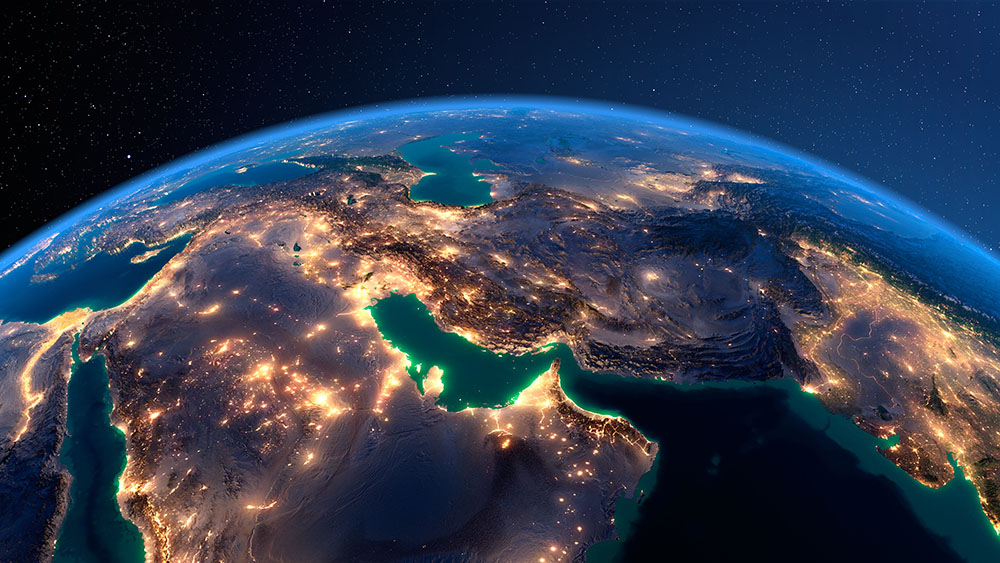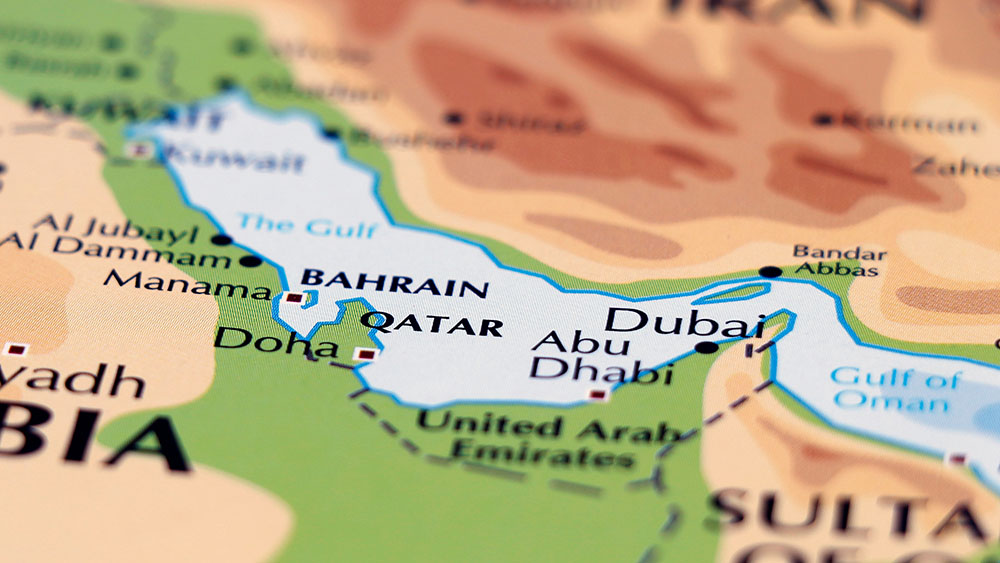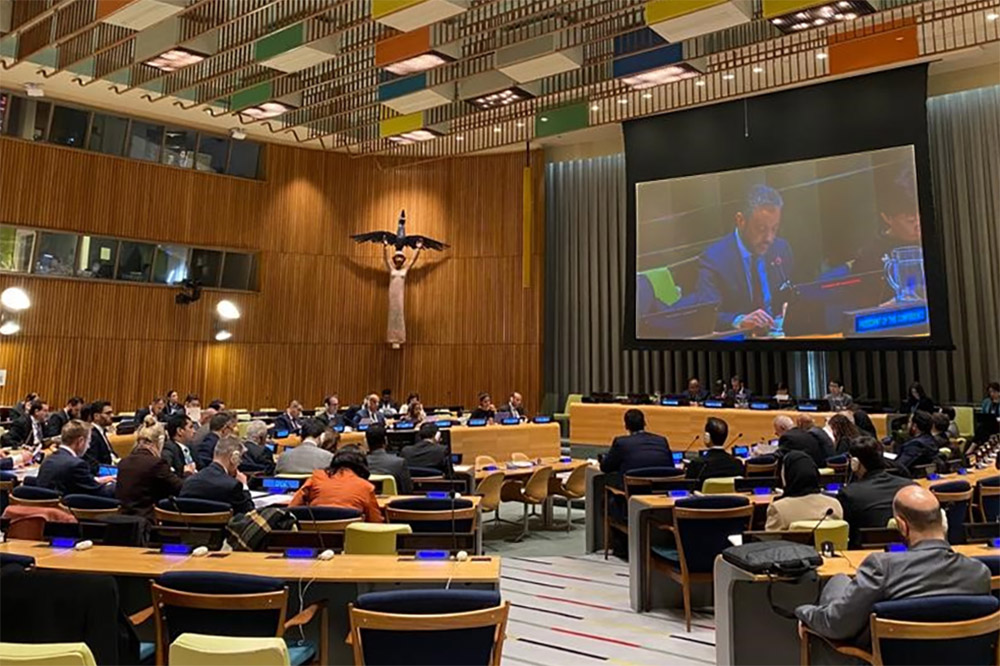The endeavour to establish the Middle East Weapons of Mass Destruction Free Zone (ME WMDFZ) has long stood as a common aspiration among states in the region. The implementation of this objective, however, has proven to be a demanding undertaking, primarily attributed to the intricate and multifaceted regional dynamics. Consequently, the forward momentum towards the realization of the ME WMDFZ has been notably slow-moving, contributing to the Gulf Cooperation Council (GCC) member states, exploring alternative pathways for addressing proliferation concerns in the region. This commentary explores the history of the Gulf Weapons of Mass Destruction Free Zone (hereafter referred to as the Gulf WMDFZ) initiative, reviews its intricacies and implications for the ME WMDFZ framework and the broader context of regional dynamics. It concludes that the current political rapprochement between Iran and Saudi Arabia opens a new favourable environment for exploring nuclear confidence-building measures as a possible next step in the Persian Gulf region.
The History of the Gulf Weapons of Mass Destruction-Free Zone Initiative
The idea of a Gulf Weapons of Mass Destruction Free Zone was officially announced by the GCC on 18 December 2005 during the 26th annual GCC summit.[1] Members to the proposed treaty included the six members of the Council (Bahrain, Kuwait, Oman, Qatar, Saudi Arabia, and the United Arab Emirates) in addition to Iraq, Iran, and Yemen.
The idea of a Gulf WMDFZ was first cultivated as a Track II initiative by the Gulf Research Centre.[2] The first meeting to introduce the initiative was held a year prior to the formal announcement in December 2004. Several other international research institutions, such as the Stockholm International Peace Research Institute and the Verification Research, Training, and Information Centre, supported the initiative by holding meetings on the prospects of a Gulf WDMFZ in May 2005 and May 2006, respectively.[3]
The deliberations regarding the establishment of a subregional WMDFZ in the Persian Gulf emerged in the aftermath of the breakdown of the 2004 Paris Agreement, the agreement between France, Germany, and the United Kingdom with Iran regarding limiting Tehran’s nuclear enrichment capabilities. The primary objective of the Gulf WMDFZ was to address the security threats that the states in the region had, largely pertaining to Iran’s nuclear ambitions. The initiative reflected a shift in priorities of security perceptions between the GCC member States and other regional states of what was before relatively unified homogenous positions within the broader ME WMDFZ framework.
During the preliminary discussion about the treaty, it was agreed that the prerequisite to the establishment of a Gulf WMDFZ would be for all states involved to be parties to the Biological Weapons Convention (BWC), Chemical Weapon Convention (CWC), and the Treaty on the Non-Proliferation of Nuclear Weapons (NPT), which all states of the proposed Gulf WMDFZ have successfully done at the time of the discussion.
However, while guarding the Persian Gulf region from proliferation risks, the idea of only creating a sub-regional arrangement does not address important proliferation issues in other parts of the region, and does not resolve some of the ongoing challenges, and possibly may not prevent further proliferation.

The Benefits of a Gulf WMD-Free Zone
There are three primary benefits to a Gulf WMDFZ. First, it could serve as a first, intermediate step a to a wider Middle East WMDFZ given the ongoing impasse concerning the latter. The establishment of a Gulf WMDFZ could signal to neighbouring states the potential gains of a broader Middle East free zone. Notably, proponents of this concept theorise that additional states from the proposed Middle East zone could join over time, drawing parallels with the Treaty of Tlatelolco in Latin America and the Treaty of Pelindaba in Africa, where regional nuclear-free zone agreements have garnered broader participation over time.
Second, a Gulf WMDFZ could address the GCC’s distinct concerns regarding Iran to prevent a situation in which GCC states may be compelled to contend in the future with a nuclear-armed Iran, re-examining their regional security strategies and possibly moving forward to forge their own nuclear capabilities. The establishment of a Gulf WMDFZ holds the potential to also promote the development of confidence-building measures (CBMs) within the Persian Gulf region, particularly concerning Iran’s nuclear program.
Third, the establishment of a Gulf WMDFZ could play a critical role in restricting nuclear non-peaceful capabilities in the region and standardizing civilian nuclear power programs among the states in the proposed Gulf WMDFZ. Several GCC members have expressed their intentions to embrace nuclear energy as part of their long-term energy strategies due to the depletion of oil and gas reserves and the growing concerns related to climate change.
While Iran’s nuclear escalation concerns some regional states more than others, the possibility of Saudi Arabia pursuing nuclear capabilities in response to Iran’s actions may have added a non-proliferation element that underscores the regional significance and further highlights the benefit of a Gulf WMDFZ to prevent nuclear competition between Saudi Arabia and Iran. Saudi Arabia has expressed a strong interest in pursuing nuclear power, with Crown Prince Mohammed Bin Salman publicly expressing the kingdom’s nuclear aspirations.[4] Specifically Saudi Arabia has emphasised that it would consider developing nuclear weapons in response to Iran’s potential acquisition of nuclear arsenal. In addition, Saudi Arabia has ambitions to domestically enrich uranium in order to establish a self-sustaining nuclear fuel cycle. If this endeavour is implemented, the United Arab Emirates (UAE) may contemplate renegotiating its existing 123 agreement with the United States, under which it forgone domestic enrichment and reprocessing capabilities, potentially initiating inter-regional competition to develop uranium enrichment capabilities.
The Challenges of a Gulf WMD-Free Zone
The adoption of the proposed Gulf WMDFZ carries with it potential implications that warrant careful consideration, particularly in light of the perspectives put forth by key stakeholders. One of the challenges to establish a Gulf WMDFZ as articulated by Amr Moussa, the then-Secretary General of the League of Arab States (LAS) is the concern that the establishment of a Gulf WMDFZ might undermine broader collective Arab efforts aimed at formulating a zone to include all states in the region, with the overarching goal of eliminating all WMD from the region.[5]
Moussa’s reservation at the time centred on Israel’s nuclear capabilities. While most GCC states share these concerns, certain members voiced a distinct perspective and priority, emphasizing that Iran’s Bushehr nuclear facilities posed a more immediate and proximate security threat to the Persian Gulf region,[6] as it is geographically closer to the Arab states’ shores than to Tehran. The region highly depends on the Persian Gulf as the primary water source[7]; therefore, the risk of a nuclear disaster is seen as a significant security concern for the GCC that trumps the prospects of a direct nuclear attack by Israel. The potential establishment of a Gulf WMDFZ could convey the impression that the GCC is prioritizing its concerns regarding Iran’s nuclear capabilities over Israel’s.

In turn, some non-Gulf Arab states are concerned that this perception would relieve some of the international pressure that has historically been brought to bear on Israel to address its nuclear program. The concern regarding Israel was that if Iran’s nuclear program is constrained by the establishment of a Gulf WMDFZ, especially if the zone goes beyond the existing framework of the NPT, then from the Israeli perspective, the threat from Iran’s nuclear capabilities is neutralized. The pressure on Israel to address its nuclear capabilities in exchange of addressing Iran’s program through joining the NPT and undertake disarmament commitments will significantly be diminished. This argument reflects the position articulated by the LAS, which held that creating a sub-regional free zone in the Persian Gulf would primarily serve the interests of the GCC and, to some extent, address the concerns surrounding Iran’s nuclear capabilities but as a result, the diplomatic pressure exerted on Israel to relinquish its nuclear arsenal may not carry as substantial an impact, given that a Gulf WMDFZ would alter the regional nuclear dynamics.
The question of Israel’s potential participation in a ME WMDFZ is of paramount importance, as its stance on nuclear disarmament significantly impacts the prospects for regional denuclearization. While some have hoped that the Gulf WMDFZ initiative could serve as a starting point for a wider Middle East WMDFZ free zone, the issue of Israel’s nuclear arsenal must be earnestly confronted in any comprehensive security dialogue to foster stability and disarmament within the Middle East.
Another concern expressed is how much the proposed Gulf ME WMDFZ could address concerns over Iran’s nuclear program. The Joint Comprehensive Plan of Action (JCPOA) adopted in 2015 was a significant milestone in addressing the Gulf states concerns over Iran’s nuclear program by implementing restrictions on Iran’s nuclear activities and ensuring their peaceful use. The withdrawal of the United States from the JCPOA in 2018 ultimately led to the deal’s collapse, and the prospects of a renewed agreement remain bleak.[8] The collapse of the JCPOA and Iran’s subsequent nuclear escalation have prompted exploring alternative solutions to address Iran’s nuclear ambitions. One potential avenue is the Gulf WMDFZ to further ensure the peaceful nature of Iran’s nuclear program. However, the Gulf WMDFZ as a way to ensure Iran’s nuclear peaceful program exhibits multifaced issues.
First, it is unlikely the Gulf WMDFZ will be as effective as the JCPOA in constraining Iran’s nuclear activities as the JCPOA’s framework incorporated strict restrictions and verification measures that went well beyond the NPT. Second, Iran’s capabilities today supressed those it had in the early 2000s when the conception of the Gulf WMDFZ was initiated. Given that Iran’s increased enrichment levels exceeds those needed for civilian nuclear activities, it stopped implementing the IAEA Additional Protocol and monitoring requirements, the only plausible way that a Gulf WMDFZ would be able to replicate similar constrains on Iran’s program and ensure its peaceful nature would be if the limitations of the free zone go beyond the framework of the NPT.
In addition, it is crucial to acknowledge that Iran alongside Egypt were the initiators of the nuclear weapon free zone (NWFZ) in the Middle East, which was later expanded to the ME WMDFZ.[9] Therefore, it is probably unlikely that Iran will agree to undermine their initiative and traditional role by agreeing to a Gulf WMDFZ, unless, at the least Israel commits to similar obligations. Further, while a Gulf WMDFZ may address GCC security perceptions vis-a-vie Iran, Iran’s main security perceptions, namely Israel, and the US involvement in the region[10] are unlikely to be addressed in such a sub-regional arrangement.
In addition, several critical aspects would need to be addressed within the framework of a Gulf WMDFZ to alleviate concerns regarding existing and future regional proliferation concerns. These include identifying the nuclear obligations under the agreement and the body that will verify the nuclear obligations, probably the International Atomic Energy Agency (IAEA) to ensure compliance, transparency, and cooperation.
In the current geopolitical and security climate, however, it is probably unlikely for Iran to willingly join a Gulf WMDFZ initiative[11] unless a substantive change in regional security dynamics are addressed, such as Israel’s nuclear ambiguity. Iran is in favour of the regional-wide model for the reasons mentioned above. At the same time, the U.S. withdrawal from the region, and the increased involvement of Russia and China have altered regional dynamics, the Israeli nuclear threat, asymmetrical capabilities, and non-proliferation obligations remain a significant issue.
Addressing complex interregional relations is also essential, particularly the competition for regional dominance between Iran and Saudi Arabia. In light of the recent Saudi-Iran deal and Saudi Arabia’s interest in civilian nuclear power plants, the prospect of nuclear cooperation between the two regional powers is an important element to explore as the deal progresses. It further raises questions regarding the likelihood of nuclear cooperation between the two states and its implications for the ME WMDFZ process.
In conclusion, the origins of the Gulf WMDFZ stemmed from concerns over sub-regional proliferation developments and frustration with the pace of progress toward a Middle East WMDFZ. At its inception, the Gulf initiative held promise as a potential steppingstone toward establishing a Middle East WMDFZ. Yet, when assessing its current trajectory, the prospects for a successful Gulf Free Zone appear increasingly challenging within the complex global political landscape. It is evident that several other regional issues and increased regional dialogue are necessary to establish any meaningful free zone in the region.
Against this backdrop, the recent improvement in relations between Tehran and Riyadh has created an opportunity for discussions on potential nuclear cooperation between these two regional powers. Such cooperation has the potential to foster CBMs not only between Saudi Arabia and Iran but also among other states within the Gulf WMDFZ. These CBMs may encompass various aspects, including military-to-military dialogues concerning disaster response strategies, the sharing of responsibilities related to nuclear enrichment, and the establishment of monitoring mechanisms, with the support and oversight of the International Atomic Energy Agency (IAEA). This collaborative approach could significantly enhance regional stability and security by fostering mutual trust and transparency in the nuclear domain.
[1] “GCC Initiative for a Gulf WMDFZ,” 18 December 2005, https://unidir.org/node/5650.
[2] Christian Koch, Ghassan Shams and Layla Ali, “The Role of Think Tanks in Public Policy: The Case of the Gulf WMD Free Zone Project,” Gulf Research Center, March 2022, https://grc.net/documents/62309c402168fTheRoleofThinkTanksinPublicPolicyCommentaryAnalysis.pdf.
[3] Mustafa Alani, “The Gulf NW and WMD Free Zone: A Track II Initiative,” International Relations 22, no 3, (September 2008): 358–362, https://doi.org/10.1177/0047117808094180.
[4] Julian Borger, “Crown Prince Confirms Saudi Arabia will seek Nuclear Arsenal if Iran Develops One,” The Guardian, 21 September 2023, https://www.theguardian.com/world/2023/sep/21/crown-prince-confirms-saudi-arabia-seek-nuclear-arsenal-iran-develops-one.
[5] “Letter from SG of the Arab League of the SG of the GCC Objecting to the Gulf WMD Free Zone Initiative,” 26 July 2005, https://unidir.org/node/6985.
[6] “UAE Responds to a Letter from the SG of the Arab League,” 20 December 2005, https://unidir.org/node/6987.
[7] Najmedin Meshkati, “Gulf Escalation Threatens Drinking Water,” The Belfer Center for Science and International Affairs, 26 June 2019, https://www.belfercenter.org/publication/gulf-escalation-threatens-drinking-water.
[8] Maziar Motamedi, “Five Years After Trump’s Exit, No Return to the Iran Nuclear Deal,” Al Jazeera, 8 May 2023, https://www.aljazeera.com/news/2023/5/8/five-years-after-trumps-exit-no-return-to-the-iran-nuclear-deal.
[9] “Iran-Egypt Joint Letter Regarding the Name of the Agenda Item on the Zone,” 22 August 1974, https://app.unidir.org/node/6146.
[10] Farzan Sabet, “Iranian Narrative,” in Narratives of the Middle East WMD-Free Zone: Drivers, Theses and Historical Accounts, 2023, Geneva: UNIDIR, https://doi.org/10.37559/MEWMDFZ/2023/narratives.
[11] Peter Jones, “A Gulf WMD Free Zone within a Broader Gulf and Missile East Security Architectures,” Gulf Research Centre, 2005, https://www.files.ethz.ch/isn/14747/2005-03_WMD%20-%20Peter%20Jones%20Digital.pdf; and Michael Crowley, Farnaz Fassihi and Ronen Bergman, “Hoping to Avert Nuclear Crisis, U.S. Seeks Informal Agreement with Iran,”14 June 2023, https://www.nytimes.com/2023/06/14/us/politics/biden-iran-nuclear-program.html.

